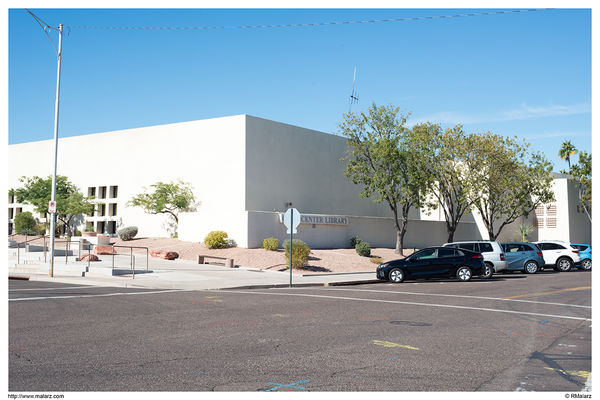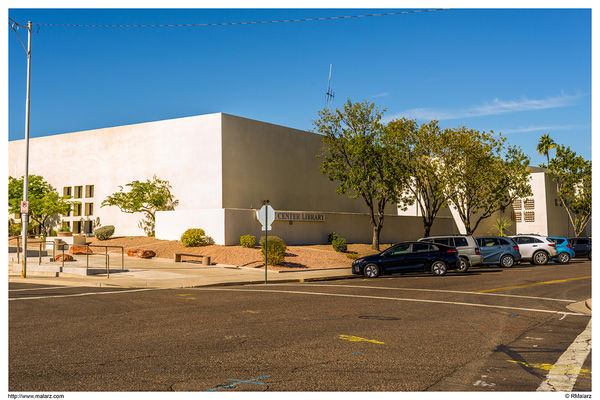Why Your Photos May Look Like Crap
Nov 11, 2017 17:02:18 #
Both photographed using RAW.
The inspiration for this is that in my reading I found a couple of keystroke that could let PS automatically set certain adjustments in ACR. I tried them. In each of those adjustments Adobe tended to push things towards the plus end of the scale and, in some cases, considerably so. This inspired me to hit the street to take and process something completely in Auto mode. To compare, I took a similar photo in manual and controlled the process throughout. There is a difference.
I tried an experiment this afternoon. I picked a very unideal time of day to photograph this building. I took one photo in which I was completely in Auto, used Auto in ACR as well. The other I used manual and was in control of everything, including using my settings in ACR. I metered the scene, using the same spot, set the exposure (knowing my camera's capabilities). Then, I took the photograph.
The first photo was taken in P mode, letting the camera decide everything. In processing, I simply let PS make the decisions by using Auto.
In processing the second photo, I did my usual basic settings and adjustments. I did nothing along the lines of burning and dodging, vignetting, etc. Just the basics to where the photo is where I'd start working on it. I did do an image specific WB on the second photo.
For those of you who have a bit of insight on my exposure settings, WB was set to Auto1 for this series. This eliminated any additional adjustments in ACR.
--Bob
The inspiration for this is that in my reading I found a couple of keystroke that could let PS automatically set certain adjustments in ACR. I tried them. In each of those adjustments Adobe tended to push things towards the plus end of the scale and, in some cases, considerably so. This inspired me to hit the street to take and process something completely in Auto mode. To compare, I took a similar photo in manual and controlled the process throughout. There is a difference.
I tried an experiment this afternoon. I picked a very unideal time of day to photograph this building. I took one photo in which I was completely in Auto, used Auto in ACR as well. The other I used manual and was in control of everything, including using my settings in ACR. I metered the scene, using the same spot, set the exposure (knowing my camera's capabilities). Then, I took the photograph.
The first photo was taken in P mode, letting the camera decide everything. In processing, I simply let PS make the decisions by using Auto.
In processing the second photo, I did my usual basic settings and adjustments. I did nothing along the lines of burning and dodging, vignetting, etc. Just the basics to where the photo is where I'd start working on it. I did do an image specific WB on the second photo.
For those of you who have a bit of insight on my exposure settings, WB was set to Auto1 for this series. This eliminated any additional adjustments in ACR.
--Bob
Nov 11, 2017 17:37:29 #
I like the second photo much more. The first one, when compared to the second one, looks washed out.
Nov 11, 2017 17:41:24 #
I always go use default to see what ACR says then go back to default and use ACR exposure -1 before doing anything else with it. I disagree with most Adobe 'default'.
Nov 11, 2017 17:43:25 #
rmalarz wrote:
Both photographed using RAW. br br The inspiratio... (show quote)
In each of those adjustments Adobe tended to push things towards the plus end of the scale
And I thought it was just me
 Particularly the exposure slider, I'll have a histogram up towards the right 'wall' and if I use auto more than half the time it'll push it to the right.
Particularly the exposure slider, I'll have a histogram up towards the right 'wall' and if I use auto more than half the time it'll push it to the right.Nov 11, 2017 17:44:20 #
To me, auto gives you a good starting point if you really messed something up. It isn't the end of processing, but might get you close enough to start your fine tuning.
--
--
Nov 11, 2017 17:49:27 #
No EXIF data. How was the metering done in each. The first is washed out- no detail in gthe white building. But the color of the road surface is more accurte in the first, which is why I asked about the metering. Too many unknowns to make a valid comparison.
Nov 11, 2017 18:28:51 #
The exposure was spot metered on the wall, with the windows, and just above the tree to the viewer's right of said windows.
There is no need for EXIF data.
I don't quite know what you mean regarding too many unknowns, unless you are referring to how the camera decides the exposure and how Adobe Camera Raw makes its decisions as well. Those are not only unknown, but out of the users control. What this emphatically indicates is that left to their own devices, images are pushed to the right considerably. As for the road surface, in real life, it actually appears more like the second photo.
--Bob
There is no need for EXIF data.
I don't quite know what you mean regarding too many unknowns, unless you are referring to how the camera decides the exposure and how Adobe Camera Raw makes its decisions as well. Those are not only unknown, but out of the users control. What this emphatically indicates is that left to their own devices, images are pushed to the right considerably. As for the road surface, in real life, it actually appears more like the second photo.
--Bob
boberic wrote:
No EXIF data. How was the metering done in each. The first is washed out- no detail in gthe white building. But the color of the road surface is more accurte in the first, which is why I asked about the metering. Too many unknowns to make a valid comparison.
Nov 11, 2017 18:32:44 #
vonzip, Rong..., and Rich, exactly the same as I discovered a couple of days ago. Left to its own, PS will tend to expose more to the right than it seems it should.
--Bob
--Bob
Nov 11, 2017 18:35:10 #
Unfortunately, in this case, Auto provided an image from which the texture and the color were not quiet capable of being rendered correctly. It almost gets there, but not quite.
--Bob
--Bob
Bill_de wrote:
To me, auto gives you a good starting point if you really messed something up. It isn't the end of processing, but might get you close enough to start your fine tuning.
--
--
Nov 11, 2017 18:38:44 #
rmalarz wrote:
The exposure was spot metered on the wall, with th... (show quote)
I prefer the 2nd to the first, seems to have better detail but i'm not sure on the white balance to me it seems to be too warm with too much yellow. With a color checker chart photographed it probably would be a little cooler and more natural looking. I wonder if you put it in photoshop if it would detect a color cast. But yes i do agree Adobes auto always gets an urgh from me and i put it back.
Nov 11, 2017 18:55:27 #
Nov 11, 2017 19:21:11 #
As far as any color cast, the overall RGB values for the first one are 140,158,171. The second are 112,122,119.
--Bob
--Bob
blackest wrote:
I prefer the 2nd to the first, seems to have better detail but i'm not sure on the white balance to me it seems to be too warm with too much yellow. With a color checker chart photographed it probably would be a little cooler and more natural looking. I wonder if you put it in photoshop if it would detect a color cast. But yes i do agree Adobes auto always gets an urgh from me and i put it back.
Nov 11, 2017 19:22:13 #
Thank you for the compliment. That's why I use manual mode. In fact, this is the first time I've photographed anything with this camera in Auto or Program mode.
--Bob
--Bob
yssirk123 wrote:
Your post processing is spot on - full auto never stood a chance.
Nov 11, 2017 19:23:31 #
rmalarz wrote:
Both photographed using RAW. br br The inspiratio... (show quote)
I know, this is a good sample to demonstrate why post processing is so important.
Nov 11, 2017 19:37:12 #
An interesting test and comparison, and thanks for the effort. However, this just scratches the surface as to why my photos look like crap, lol.
If you want to reply, then register here. Registration is free and your account is created instantly, so you can post right away.











